The Piano Lesson
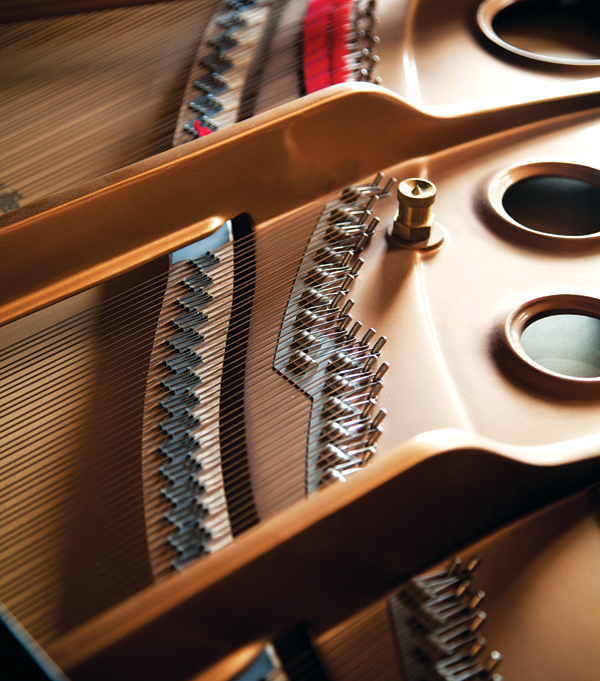
The interior of a completed piano is a mechanical masterpiece. (Photos by Pat Piasecki)
A grand piano is one of the most beautiful examples of form following function, but sadly, we see them in homes less and less these days. Among America’s oldest and most revered manufacturers, however, a few still thrive, including Mason & Hamlin, which continues to make pianos by hand in a Haverhill workshop.
Founded in 1854 by Henry Mason (son of the “father of American church music”) and Emmons Hamlin, a mechanic and inventor, the company, originally based in Boston, quickly became known for its innovative work. In fact, several famous early-20th-century composers, including Sergei Rachmaninoff and Maurice Ravel, chose Mason & Hamlin pianos to make their recordings.
Over the years, the business changed ownership several times, eventually moving to New York in the 1930s. Several decades later, Bruce Clark joined Mason & Hamlin, but by that time, the engineer says, the quality of the pianos had begun to wane. In 1990, the company moved to Haverhill to share a six-story facility with the now-defunct piano maker Falcone. The close quarters proved advantageous: By 2007, Mason & Hamlin had gone from manufacturing two piano models to a full product line of five grand pianos and one upright. “The Falcone people cared passionately about good instruments, and Mason & Hamlin benefited greatly from that environment,” Clark says.
Today, 40-plus craftspeople in the factory and 10 more in other departments labor to create the instruments, which range from $50,000 to more than $100,000 and take about three months to construct. To learn about how these beautiful pianos are built, we asked Clark to take us on a factory tour.
On the day of our visit, we begin in the basement, where rough-dimensioned wood—primarily New England maple—is brought in from Tewksbury and cut to size. Like a light dusting of snow, sawdust covers the factory floor, making it incredibly slippery. Above, electric rollers spread glue onto the wooden sheets, which are then laminated together to achieve the correct thickness for the piano case—up to 25 sheets, depending on the model. Wet from the glue, the layers are bent into the piano’s recognizable “S” curve and held in place by the steel arms of a massive rim press. After about a month, the case is completely dry, and braces, or struts, are built inside the rim to give it support. Then the tension resonator—a steel-rod contraption—is fastened atop the braces to keep the rims from spreading apart when the piano strings are tightened. Next, the spruce soundboard, with its bass and treble bridges, is lowered and glued into the piano rim. The piano’s strings will straddle the bridges, transmitting vibrations to the soundboard, which acts as a natural amplifier.
A craftsman makes notches in the bridges with a chisel, each of which will cradle three piano strings. Curls of wood come off his tool like butter. “There’s no machine that can do this better than he can,” Clark says. Next, workers use spinning cutters to shape the arms on either side of the keyboard before the outer rim is sanded, painted black, buffed, and glazed to a satin or mirror finish. At this point, the instrument is half complete. Finally, a crew installs a gold-painted cast-iron plate that will bear the roughly 50,000 pounds of tension created when the piano is strung up, then fits the key frame into the instrument.
When we’re nearing the top floor, we hear what sounds like the soundtrack to a horror flick coming from behind closed doors: blaring scales repeated over and over at a maddening pace. “We have a piano in the pounder,” says Clark, chuckling. “The pounder beats the living daylights out of each instrument for about 10,000 blows in order to stabilize all the little parts.” Then, he says, mechanical tests are done and the piano is inspected before it’s shipped off to a dealer.
Mason & Hamlin produces three pianos each week, about half of its production rate before the recession. But now that the economy is improving, Americans, in particular, are most likely to make the investment. “The United States is the world’s largest consumer of grand pianos, buying about 40 percent of those made,” says Kirk Burgett, who purchased the company in 1996 with his brother, Gary. “Our homes can handle the size. It’s always a go-to for the interior decorator, and really, there’s nothing that dominates a room like a grand piano—is there?”

Gold-painted cast-iron plates wait to be mounted on piano rims, over the soundboards.
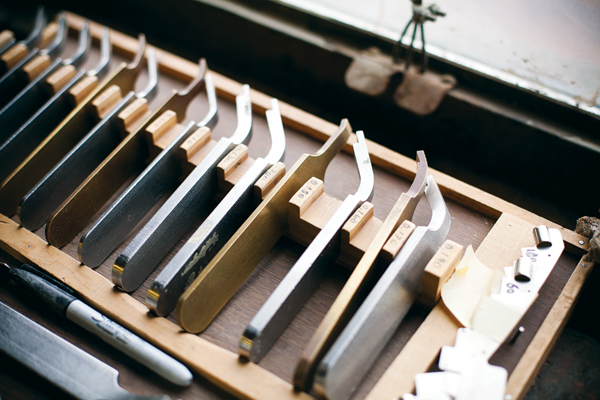
Gauges are machined to different thicknesses that correspond with bearing settings throughout the piano.

Each instrument is finely tuned by a master technician.

A sketch of a Mason & Hamlin A5 model, drawn in the early ’90s, is taped to the wall.
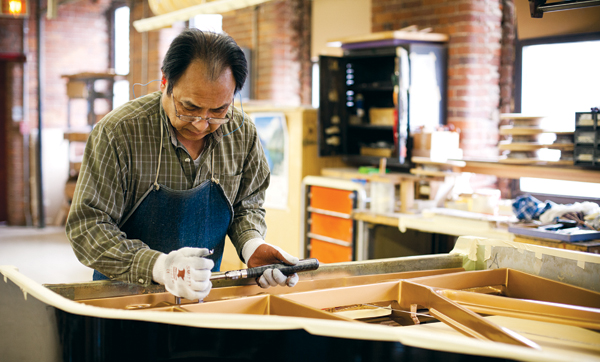
A craftsman brings the strings to pitch using a tuning hammer.
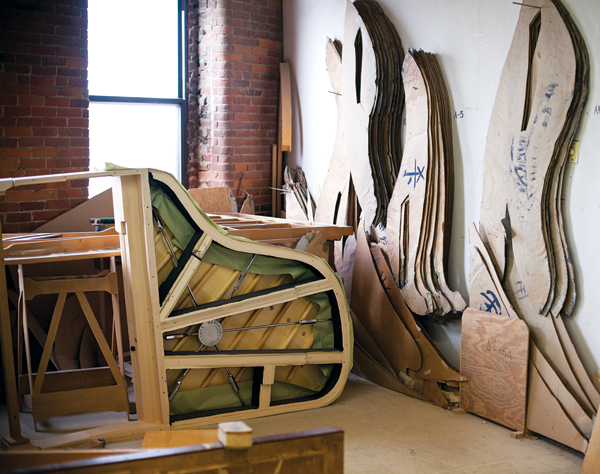
Stencil-like templates ensure that the cutting of the various parts is precise.

Once made of ivory and ebony wood, today’s piano keys are covered in plastic.
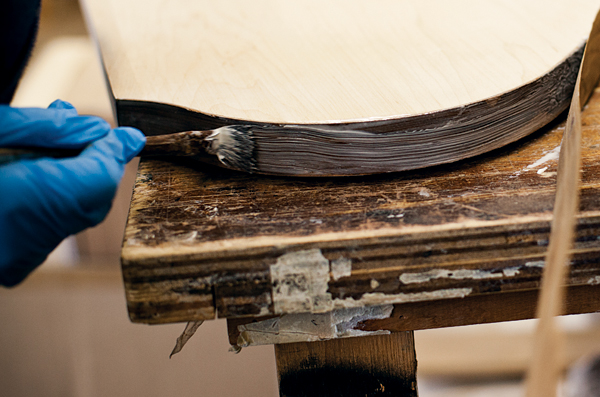
A thin layer of glue is applied to the console to keep the piano leg in place.

Workers load the laminated wood, wet with glue, into the rim press to be bent into the desired curve.

A technician sets the hammer line so the keys will function properly when the notes are played.
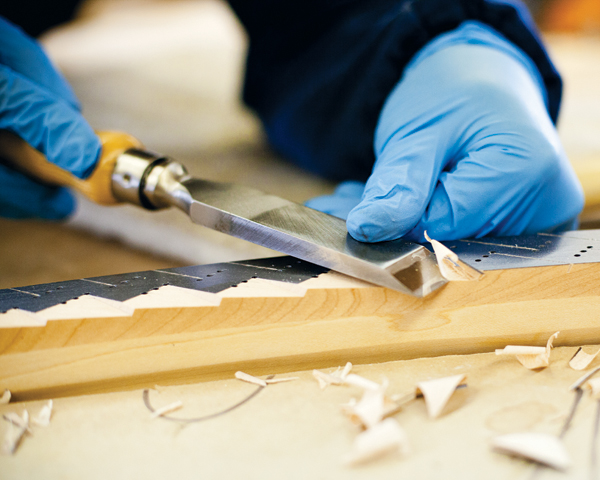
Using a chisel, a worker cuts away material in the bridge to allow the strings to vibrate freely.

Laminated rims dry in steel presses for 24 hours after the initial gluing.
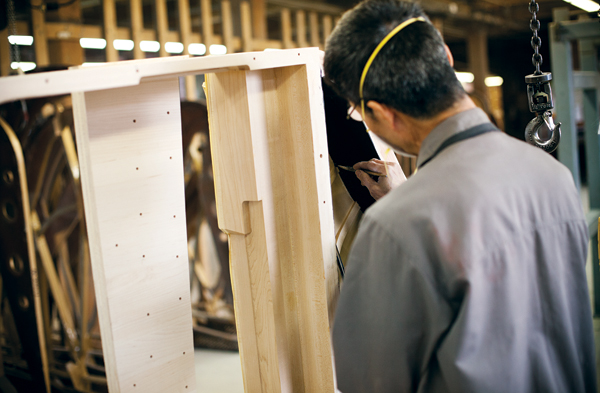
Before the instrument is assembled, a worker uses a fine brush to touch up the finish on the inside of the case.

The piano skeleton, complete with its soundboard, is ready to be inserted in its case.
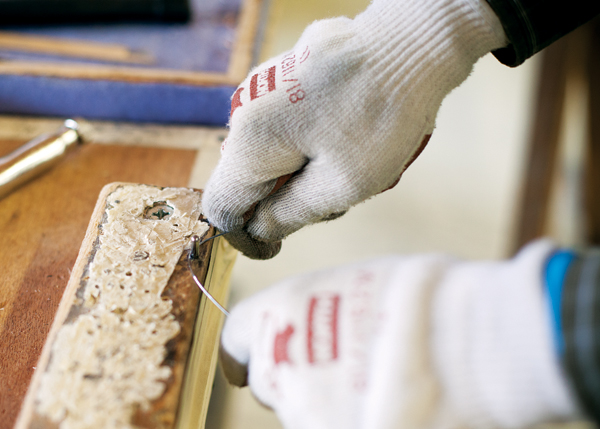
Piano wire is wrapped around a hitch pin—the other end of the wire will be threaded through the tuning pin and tightened to pitch.

The ribs near the perimeter of the soundboard are thinner to make it more flexible and resonant.


